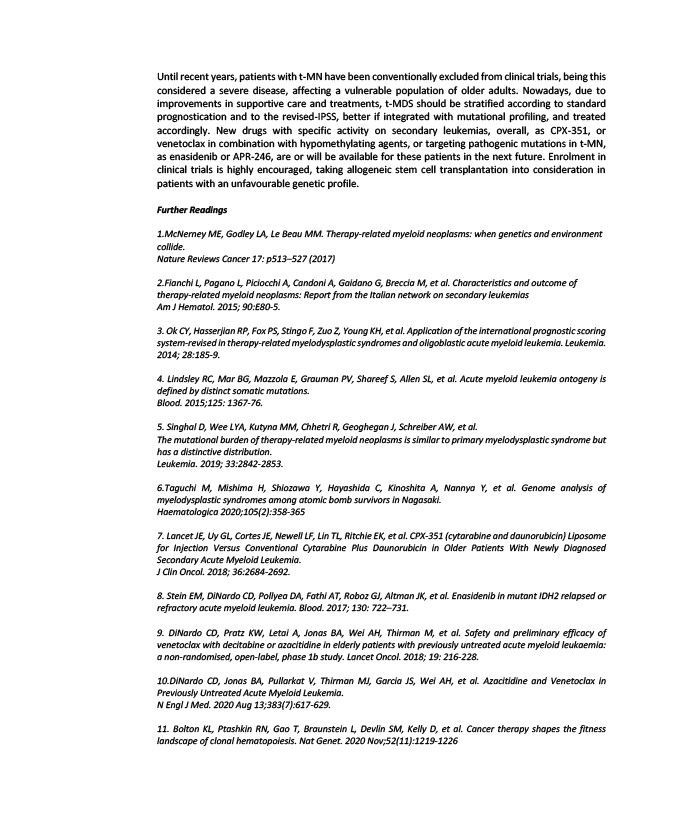
Until recent years, patients with t-MN have been conventionally excluded from clinical trials, being this
considered a severe disease, affecting a vulnerable population of older adults. Nowadays, due to
improvements in supportive care and treatments, t-MDS should be stratified according to standard
prognostication and to the revised-IPSS, better if integrated with mutational profiling, and treated
accordingly. New drugs with specific activity on secondary leukemias, overall, as CPX-351, or
venetoclax in combination with hypomethylating agents, or targeting pathogenic mutations in t-MN,
as enasidenib or APR-246, are or will be available for these patients in the next future. Enrolment in
clinical trials is highly encouraged, taking allogeneic stem cell transplantation into consideration in
patients with an unfavourable genetic profile.
Further Readings
1.McNerney ME, Godley LA, Le Beau MM. Therapy-related myeloid neoplasms: when genetics and environment
collide.
Nature Reviews Cancer 17: p513–527 (2017)
2.Fianchi L, Pagano L, Piciocchi A, Candoni A, Gaidano G, Breccia M, et al. Characteristics and outcome of
therapy-related myeloid neoplasms: Report from the Italian network on secondary leukemias
Am J Hematol. 2015; 90:E80-5.
3. Ok CY, Hasserjian RP, Fox PS, Stingo F, Zuo Z, Young KH, et al. Application of the international prognostic scoring
system-revised in therapy-related myelodysplastic syndromes and oligoblastic acute myeloid leukemia. Leukemia.
2014; 28:185-9.
4. Lindsley RC, Mar BG, Mazzola E, Grauman PV, Shareef S, Allen SL, et al. Acute myeloid leukemia ontogeny is
defined by distinct somatic mutations.
Blood. 2015;125: 1367-76.
5. Singhal D, Wee LYA, Kutyna MM, Chhetri R, Geoghegan J, Schreiber AW, et al.
The mutational burden of therapy-related myeloid neoplasms is similar to primary myelodysplastic syndrome but
has a distinctive distribution.
Leukemia. 2019; 33:2842-2853.
6.Taguchi M, Mishima H, Shiozawa Y, Hayashida C, Kinoshita A, Nannya Y, et al. Genome analysis of
myelodysplastic syndromes among atomic bomb survivors in Nagasaki.
Haematologica 2020;105(2):358-365
7. Lancet JE, Uy GL, Cortes JE, Newell LF, Lin TL, Ritchie EK, et al. CPX-351 (cytarabine and daunorubicin) Liposome
for Injection Versus Conventional Cytarabine Plus Daunorubicin in Older Patients With Newly Diagnosed
Secondary Acute Myeloid Leukemia.
J Clin Oncol. 2018; 36:2684-2692.
8. Stein EM, DiNardo CD, Pollyea DA, Fathi AT, Roboz GJ, Altman JK, et al. Enasidenib in mutant IDH2 relapsed or
refractory acute myeloid leukemia. Blood. 2017; 130: 722–731.
9. DiNardo CD, Pratz KW, Letai A, Jonas BA, Wei AH, Thirman M, et al. Safety and preliminary efficacy of
venetoclax with decitabine or azacitidine in elderly patients with previously untreated acute myeloid leukaemia:
a non-randomised, open-label, phase 1b study. Lancet Oncol. 2018; 19: 216-228.
10.DiNardo CD, Jonas BA, Pullarkat V, Thirman MJ, Garcia JS, Wei AH, et al. Azacitidine and Venetoclax in
Previously Untreated Acute Myeloid Leukemia.
N Engl J Med. 2020 Aug 13;383(7):617-629.
11. Bolton KL, Ptashkin RN, Gao T, Braunstein L, Devlin SM, Kelly D, et al. Cancer therapy shapes the fitness
landscape of clonal hematopoiesis. Nat Genet. 2020 Nov;52(11):1219-1226